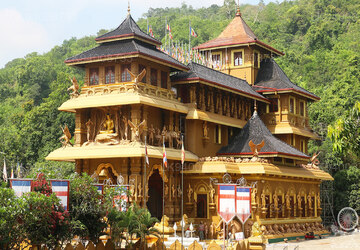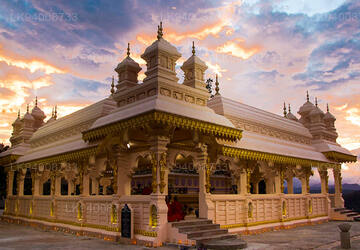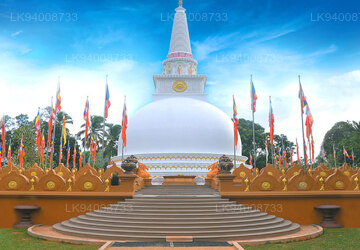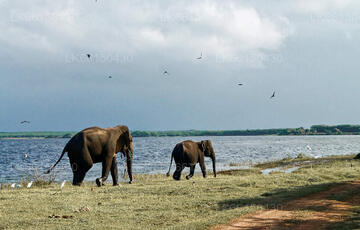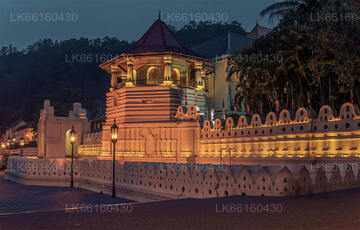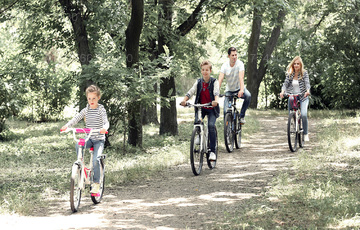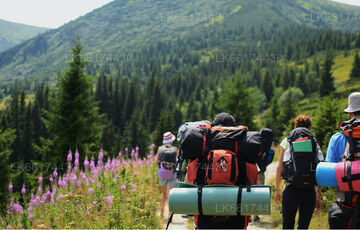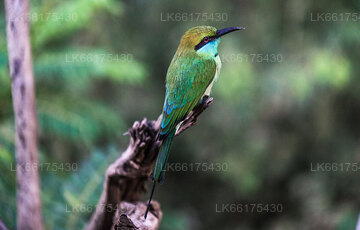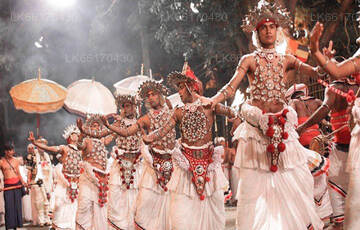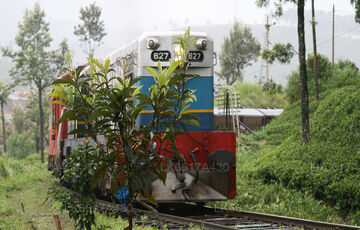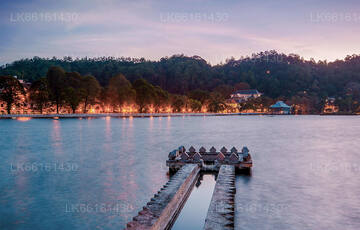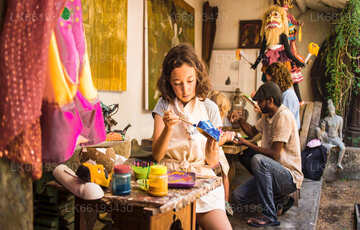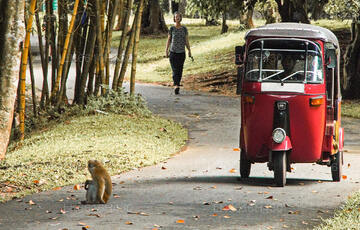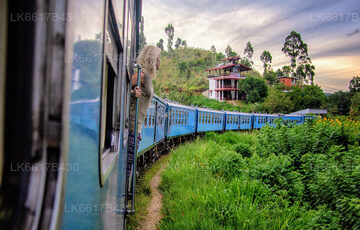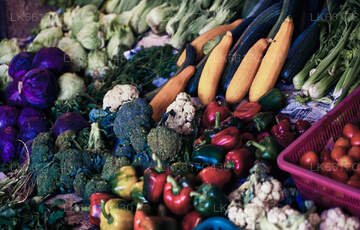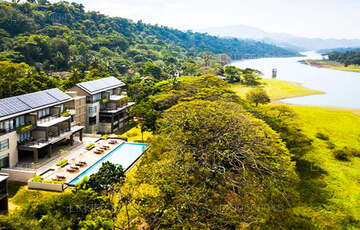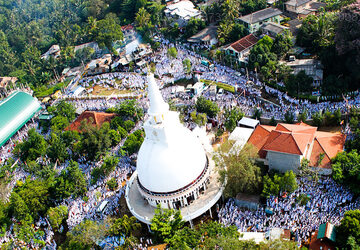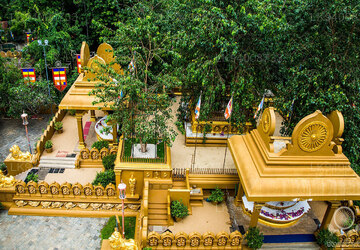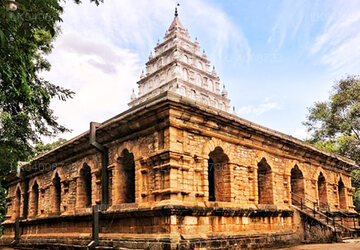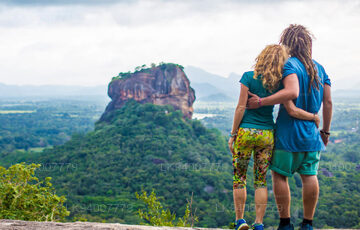

Kandy City
Kandy, a picturesque city in central Sri Lanka, is renowned for its rich cultural heritage, vibrant festivals, and scenic beauty. Nestled amidst lush hills, it is home to the Temple of the Tooth Relic, a UNESCO World Heritage Site, and offers a captivating blend of history and natural splendor.
クンダセール
クンダセールについて
クンダセールは、スリランカ中部州キャンディ地区にあるかつての町で、現在はキャンディの郊外です。この町はキャンディの中心部から南東 7 km に位置しています。人口は約15万人。
クンダセールの歴史
キャンディ最後のシンハラ王であるヴィラ パラクラマ ナレンドラ シンハ王は、1710 年に宮殿をキャンディからクンダセールに移転することを決定しました。彼は地元の知事ラムクウェル・ディサウェに宮殿複合施設を建設するよう指示した。ランブクウェル・ディサウェは建築業者デヴェンドラの協力を得て、ナリケレの庭園の丘の上に完全に木で宮殿を建てました。この宮殿は王宮というよりは夏の宮殿であったと言われています。彼はクンダセールをキャンディアン王国の首都とした最初で最後の王でした。国王は 1739 年 5 月に亡くなり、1804 年にアーサー ジョンソン大尉指揮下のイギリス軍が宮殿を攻撃し、貴重品を略奪し、焼き払った。建物の残骸は、近くのシュリ ナレンドラシンヘ ラジャマハ ヴィハラヤの建設に使用されました。ダラダ マーリガワ寺院(聖歯寺)の正門マハワハルカダにある 2 頭の象の石の彫刻は、クンダサレ宮殿の遺跡から出土したと言われています。しかし、それらは 1989 年のジャナタ ヴィムクティ ペラムナによる寺院への攻撃で破壊されました。
キャンディ地区について
キャンディ地区はスリランカ中部に位置します。スリランカにある 7 つの世界遺産の 1 つであるキャンディは、かつて 16 世紀にキャンディ王の本拠地であり、国内のあらゆる音楽、芸術、工芸、文化の源でした。コロンボから約 129 km 離れたキャンディは丘陵地帯の中にあり、魅力的な特徴を形成するキャンディ湖が街の中心部に注目を集めています。キャンディはスリランカにとって宗教的に大きな重要性を保っています。なぜなら、この魅力的な都市にはダラダ マーリガワ、つまり「歯の寺院」があり、その中に仏陀の神聖な歯の遺物が厳重に守られているからです。ペラデニヤ王立植物園は、ペラデニヤの市内中心部から西に約 5 km に位置し、年間 120 万人が訪れます。島内最大の植物園です。ウダワッタ ケレ (ウダワッタの森) は、都市の中心部、仏歯寺のすぐ北に位置する保護された聖域です。キャンディはシンハラ人が多数を占める都市です。ムーア人やタミル人など、他の民族グループに属する大きなコミュニティもあります。キャンディはコロンボに次ぐスリランカ経済の中心地です。多くの主要な協同組合がキャンディに大規模な支店役員を置き、繊維、家具、情報技術、宝飾品などの多くの産業がここにあります。市内には多くの農業研究センターがあります。そしてこの国のあらゆる音楽、芸術、工芸、文化の源でもあります。コロンボから約 129 km 離れたキャンディは丘陵地帯の中にあり、魅力的な特徴を形成するキャンディ湖が街の中心部に注目を集めています。キャンディはスリランカにとって宗教的に大きな重要性を保っています。なぜなら、この魅力的な都市にダラダ マーリガワ、つまり仏歯寺があり、その中に仏陀の神聖な歯の遺物が厳重に守られているからです。
中部州について
スリランカ中部州は主に山岳地帯で構成されています。州の面積は 5,674 km²、人口は 2,421,148 人です。主要な町としては、キャンディ、ガンポラ (人口 24,730 人)、ヌワラ エリヤ、バンダラウェラなどがあります。人口はシンハラ人、タミル人、ムーア人の混合です。丘陵地帯の首都キャンディとヌワラ エリヤ市は、スリ パダと同様に中部州内に位置しています。この州は、壊滅的な病気によって州内のすべてのコーヒー農園が壊滅した後、1860年代にイギリス人によって植えられた有名なセイロン茶の多くを生産しています。中部州には、キャンディ、ガンポラ、ハットン、ヌワラエリヤなどの丘陵地帯の町があり、多くの観光客が集まります。こめかみの歯、またはダラダ マリガワは中部州の主な神聖な場所です。気候は冷涼で、標高1500メートル付近の地域では夜が冷え込むことが多いです。西側の斜面は非常に湿っており、年間降水量が 7000 mm 近くに達する場所もあります。東斜面は北東モンスーンからのみ雨が降るため、中乾燥地帯の一部です。気温はキャンディの 24 °C から、海抜 1,889 m に位置するヌワラ エリヤのわずか 16 °C までです。スリランカの最高峰は中部州にあります。地形はほとんどが山地で、深い谷が切れ込んでいます。 2 つの主要な山地は、中央山塊とキャンディの東にあるナックルズ山脈です。
About Kandy District
Kandy district is situated in the centrel province of Sri Lanka. One of the seven World Heritage Sites in Sri Lanka, Kandy was once home to the Kandyan Kings of yore in the 16th-century and a fountainhead for all the music, arts, crafts and culture in the country. About 129 km away from Colombo, Kandy is ensconced amongst a hilly terrain and all eyes are drawn to the centre of the city, where the Kandy Lake forms a charming feature. Kandy retains great religious significance for Sri Lanka, because it is in this charming city that the Dalada Maligawa or "Temple of the Tooth" is located, within which the sacred tooth relic of Lord Buddha lies well guarded.
The Royal Botanical Garden, Peradeniya is situated about 5 km to the west of the city centre at Peradeniya and is visited by 1.2 million people per year. It is the largest botanical garden on the island. The Udawatta Kele (Udawatta Forest) is a protected sanctuary situated in the heart of the city, just north of Temple of the Tooth.
Kandy is a Sinhala majority city; there are sizeable communities belonging to other ethnic groups, such as Moors and Tamils. Kandy is second only to Colombo the center of the Sri Lankan Economy. Many major co operations have large branch officers in Kandy and many industries include textiles, furniture, Information Technology and jewellery are found here. Many agriculture research centers are located in the city.
And a fountainhead for all the music, arts, crafts and culture in the country. About 129 km away from Colombo, Kandy is ensconced amongst a hilly terrain and all eyes are drawn to the centre of the city, where the Kandy Lake forms a charming feature. Kandy retains great religious significance for Sri Lanka , because it is in this charming city that the Dalada Maligawa or Temple of the Toothis located, within which the sacred tooth relic of Lord Buddha lies well guarded.
About Central Provincce
The Central Province of Sri Lanka consists primarily of mountainous terrain. The province has an area of 5,674 km², and a population of 2,421,148. Some major towns include Kandy, Gampola (24,730), Nuwara Eliya and Bandarawela. The population is a mixture of Sinhalese, Tamil and the Moors.
Both the hill capital Kandy and the city of Nuwara Eliya are located within the Central Province as well as Sri Pada. The province produces much of the famous Ceylon tea, planted by the British in the 1860s after a devastating disease killed all the coffee plantations in the province. Central Province attracts many tourists, with hill station towns such as Kandy, Gampola, Hatton and Nuwara Eliya. Temple tooth or Dalada maligawa is the main sacred place in Centrel province.
The climate is cool, and many areas about 1500 meters often have chilly nights. The western slopes are very wet, some places having almost 7000 mm of rain per year. The eastern slopes are parts of the mid-dry zone as it is receiving rain only from North-Eastern monsoon. The Temperatures range from 24°C at Kandy to just 16°C in Nuwara Eliya, which is located 1,889 m above sea level. The highest mountains in Sri Lanka are located in the Central Province. The terrain is mostly mountainous, with deep valleys cutting into it. The two main mountain regions are the central massif and the Knuckles range to the east of Kandy.

